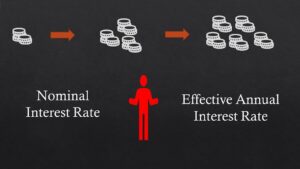We all know the meaning of Interest rate, but how many of us know the difference between Nominal Interest Rate (NIR) and Effective Annual Interest Rate (EAIR)?
The reason why i think writing about this is important is because recently i had had a meeting with an Operational head of a leading NBFC who had some difficulty in understanding these terms.
Lets first establish what Interest Rate means. It is a rate, usually expressed in Percentage, that the lender charges a borrower on a principal amount that has been exchanged between them. It also refers to what we earn when we make a deposit or investment. If we delay our consumption and instead investment the money, we earn a certain interest on the amount investmented as a reward for delayed consumption. Same happens when we borrow a loan. When we take an advance, we pay a certain amount in excess of Principal amount, which is the lender’s reward for his delayed consumption.
Please understand that Interest Rate and Return on an Investment are not the same.
Nominal Rate of Interest is an interest rate which does not take into account the compounding periods. Effective Rate of Interest does take into account the compounding periods.
This means, whenever more than one payment is made in a year, like the monthly payment made towards a loan in the form of an EMI, NIR and EAIR will be different.
In annual compounding, EAIR and NIR will be the same.
NIR can either be equal to EAIR or less than EAIR. EAIR will never in any circumstance be lower than NIR.
The more number of compounding in a year, the higher will be the effective annual interest rate in comparison with the Nominal Interest Rate.
To understand better, let us consider an example.
Lets say Mr. A invests Rs. 100 in a investment product which gives a return of 12% p.a compounded monthly.
we have to find the EAIR.
Here, number of compounding in a year is 12
Investment Rs. 100
NIR = 12%
Generally, the common mistake we make is to multiply the Interest with Principal amount and arrive at Rs.12. (100*12%)
However, every month we are earning Rs.1, and in the subsequent month, interest is being calculated on the Principal amount as well as the Interest amount credited in the previous month.
in the given scenario, EAIR will be calculated as follows:
EAIR = ( ( ( 1 + ( NIR / k ) ) ^ ( k) ) – 1 ) * 100
Where, k is the number of compounding in a year.
EAIR = ( ( ( 1 + ( 0.12 / 12 ) ) ^ ( 12 ) – 1 ) * 100
= ( ( 1.01 ) ^ 12) -1 ) *100
= 0.1268250301 * 100
= 12.68 %
In Excel, we can calculate EAIR and NIR using functions =effect and =nominal respectively.
We know that EAIR is either equal to or more than NIR. Therefore, Lenders generally quote NIR to attract more borrowers and Investment Products usually quote EAIR to attract more investments.
I hope this explanation has been helpful. Please feel free to reach out for any confusion or feedback.
Thank you.
